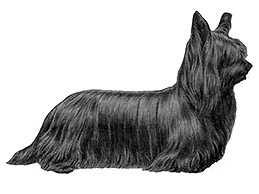Skye Terrier Breed Standard
Last updated: 22 May 2009
A breed standard is the guideline which describes the ideal characteristics, temperament, and appearance of a breed and ensures that the breed is fit for function with soundness essential. Breeders and judges should at all times be mindful of features which could be detrimental in any way to the health, welfare or soundness of this breed.

Kennel Club, London 1994
FCI Standard No 75
-
Group:
Group 2 (Terriers)
-
History:
-
General Appearance:
Long, low, with coat of good length, twice as long as high. Moves with seemingly effortless gait. Strong in quarters, body and jaw.
-
Characteristics:
-
Temperament:
A 'one-man' dog, distrustful of strangers, never vicious.
-
Head And Skull:
Long and powerful, strength not sacrificed for extreme length. Moderate width at back of skull, tapering gradually with slight stop to strong muzzle. Nose black.
-
Eyes:
Brown, preferably dark brown, medium in size, close set and full of expression.
-
Ears:
Prick or drop. When prick, gracefully feathered, not large, erect at outer edges and slanting towards each other at inner edge, from peak to skull. When drop, larger, hanging straight, lying flat and close at front.
-
Mouth:
Jaws strong and level with perfect, regular scissor bite, i.e. upper teeth closely overlapping the lower teeth and set square to the jaws.
-
Neck:
Long and slightly crested.
-
Forequarters:
Shoulders broad, close to body, chest deep, legs short and muscular.
-
Body:
Long and low, back level. Ribcage oval, deep and long. Short loin. Sides appear flattish due to straight falling coat.
-
Hindquarters:
Strong, full, well developed and well angulated. Legs short, muscular and straight when viewed from behind. No dew claws.
-
Feet:
Forefeet larger than hind, pointing truly forward. Pads thick, nails strong.
-
Tail:
When hanging, upper part pendulous and lower half thrown back in a curve. When raised, a prolongation of incline of back, not rising higher nor curling up. Gracefully feathered.
-
Gait/Movement:
Legs proceed straight forward when travelling. When approaching, forelegs form a continuation of straight line of front, feet being same distance apart as elbows. Principal propelling power is furnished by hind legs which travel straight forward. Forelegs moving well forward, without too much lift. Whole movement termed free, active and effortless and gives a more or less fluid picture.
-
Coat:
Double. Undercoat short, close, soft and woolly. Outer coat reasonable length, hard, straight, flat and free from curl, never impeding action. Hair on head shorter, softer, veiling forehead and eyes, but not obscuring vision. Mingling with side locks, surrounding ears like a fringe and allowing their shape to appear.
-
Colour:
Black, dark or light grey, fawn, cream, all with black points. Any self colour allowing shading of same colour and lighter undercoat, so long as nose and ears are black. A small white spot on chest permissible.
-
Sizes:
Height: Dogs 25-26 cms (10 ins)
Length from tip of nose to tip of tail 105 cms (41.5 ins). Bitches slightly smaller in same proportions.
-
Faults:
Any departure from the foregoing points should be considered a fault and the seriousness with which the fault should be regarded should be in exact proportion to its degree and its effect upon the health and welfare of the dog.
-
Notes:
Male animals should have two apparently normal testicles fully descended into the scrotum.
 For owners
For owners
 Members
Members
 Dogs Australia is a not-for-profit organisation advocating for the preservation of purebred dogs through ethical breeding.
It champions the highest standard of animal welfare through education and fostering dog-loving communities.
Internationally recognised and established in 1958 as the Australian National Kennel Council (ANKC),
the organisation promotes responsible dog ownership; maintains the ORCHID* heritable canine diseases database;
funds research into canine diseases; and supports state and territory-based member bodies.
Dogs Australia promotes breed conformation shows and community sports for dogs that fulfil a breed’s natural instincts.
Dogs Australia is a not-for-profit organisation advocating for the preservation of purebred dogs through ethical breeding.
It champions the highest standard of animal welfare through education and fostering dog-loving communities.
Internationally recognised and established in 1958 as the Australian National Kennel Council (ANKC),
the organisation promotes responsible dog ownership; maintains the ORCHID* heritable canine diseases database;
funds research into canine diseases; and supports state and territory-based member bodies.
Dogs Australia promotes breed conformation shows and community sports for dogs that fulfil a breed’s natural instincts.







